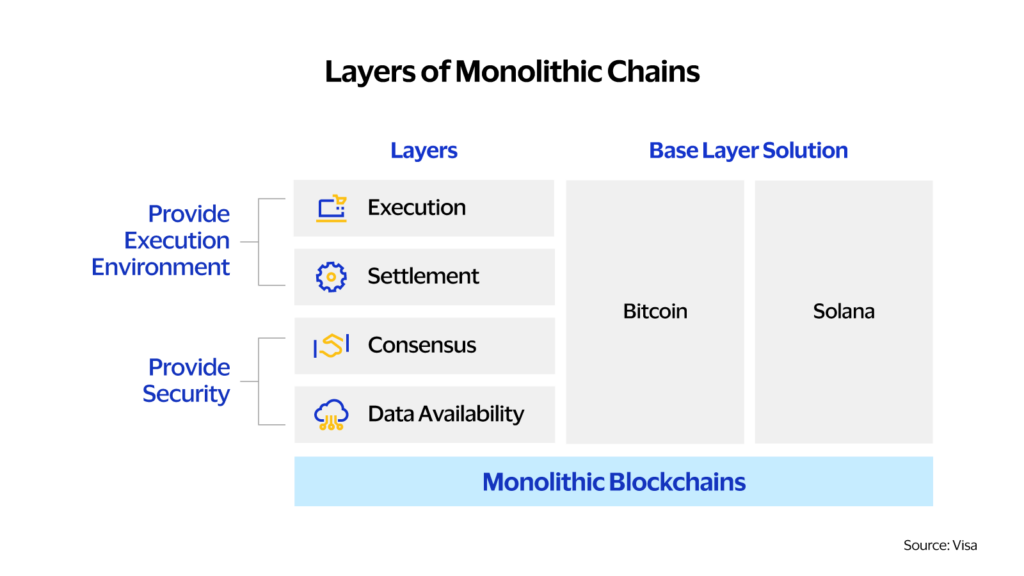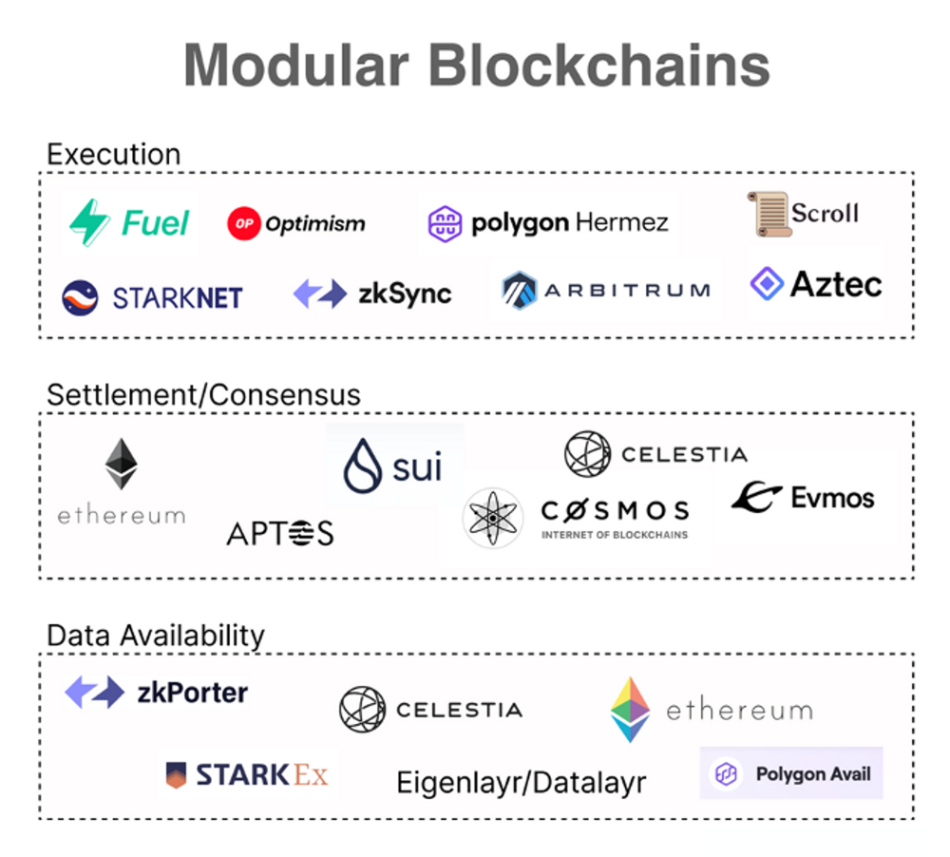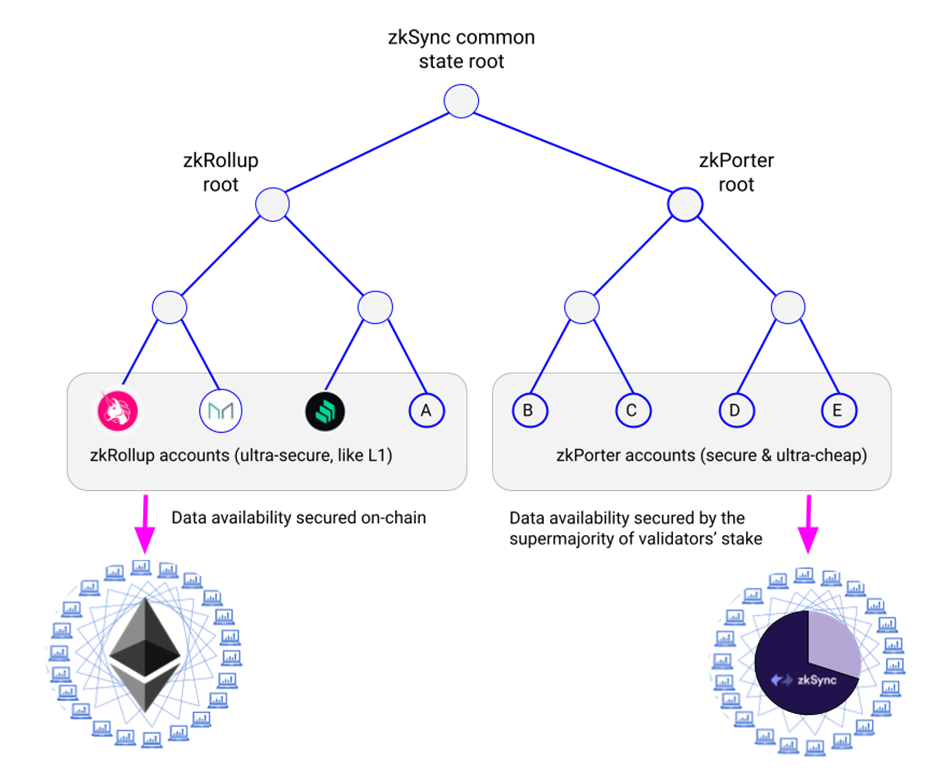The Blockchain technology has undergone significant development over a considerable period of time. Initially, the concept aimed at decentralization, transparency, and security. However, at present, this technology is advancing rapidly, as a result, the demand for scalability and integration into practical usage is also an important factor.
Since the inception of Bitcoin in 2009, the monolithic blockchain has become the industry standard. New blockchains are built and developed based on this standard. Over the past decade, continuous development has revealed that the performance of the monolithic blockchain design is no longer optimal and is considered outdated technology. Modular blockchains are gradually becoming more popular with their optimized designs and technologies compared to monolithic blockchains.
Disclaimer: This information is not financial advice, and you are always responsible for the investment.
The fundamental concept of blockchain
Execution: Processing transactions to transition between states in the blockchain.
Settlement: Resolving disputes when consensus is reached, ensuring the immutability of transactions on the blockchain.
Consensus: The shared agreement on the validity of transactions, establishing consensus on the validity of state transitions on the blockchain.
Data availability: The process of ensuring access rights to the requested data within the blockchain. Block builders must publish transaction data for nodes in the network to download and store. This ensures accessibility to transaction data and ensures accuracy for the operation of the blockchain.
Additionally, there is typically a Network layer, which is the communication layer between full nodes, light nodes, users, etc.
Current issues with blockchain technology
- The Scalability of current blockchains is limited in terms of processing a large number of transactions.
- The Decentralization level of most blockchains, excluding Bitcoin and Ethereum, is primarily centralized, controlled, and operated by foundations.
- The Security level of current blockchains is susceptible to attacks from external parties.
These three issues constitute a problem that currently no blockchain has been able to solve, known as the Blockchain Trilemma. This problem states that a blockchain can only address 2 out of the 3 mentioned issues and must sacrifice the remaining aspect.

For instance:
- If we want to have a blockchain with faster processing speed, we would need to reduce the number of nodes. However, reducing the number of nodes means reducing the security and decentralization of the blockchain.
- If we want to optimize security and decentralization, we would need to decrease the criteria and increase the number of nodes. However, increasing the number of nodes means we would have to wait for consensus among a larger number of nodes, resulting in longer transaction confirmation times.
Monolithic Blockchain & Modular Blockchain
Monolithic Blockchain

Monolithic Blockchain is the initial design concept in building a blockchain. With this design, the blockchain has to handle everything, including ensuring consensus among nodes, data availability, transaction processing, and transaction validation.
Monolithic Problems
Monolithic blockchains, with their approach of trying to do everything in one blockchain, encounter several issues, such as:
High hardware requirements: In order to increase transaction processing speed and handle more transactions, nodes need to have higher hardware configurations to meet the demands.
Bootstrapping validators: Deploying a new monolithic blockchain requires the cost of safely bootstrapping validators and maintaining network consensus.
Blockchain Trilemma: Monolithic blockchains also face the challenges posed by the Blockchain Trilemma.
Modular Blockchain

If a blockchain tries to perform all three functions mentioned above (consensus, execution, and data availability), it will eventually reach the system’s capacity limit. The solution is to break down the system into smaller components so that they can operate and develop independently.
Modularity means dividing tasks into smaller processing units, where the execution layer is independent of the data availability layer and consensus layer. This allows nodes to perform transactions separately instead of having to process all transactions to validate their validity. Thus, they can be understood as a collection of multiple solutions to address the current challenges of blockchain.
Modular Problems
Although modularity solves more problems compared to monolithic approaches, it still has some drawbacks:
Complexity: This design is quite complex and requires the involvement of professional operators. With multiple layers in the blockchain, there are more points that can be vulnerable to attacks and exploits.
Comparison of monolithic and modular blockchain designs

Typical modular designs

Layer 2
Layer 2 refers to the execution layers of Ethereum, which encompass six types of Ethereum extension solutions, namely Optimistic rollup, Zk rollup, State channel, Sidechains, Validium, and Plasma. The two prominent Layer 2 solutions currently being developed and garnering significant attention from the community are Optimistic rollup and Zk rollup.
Despite the existence of multiple scalability solutions, Optimistic rollup and Zk rollup have outpaced their competitors and are constructing robust developmental ecosystems for themselves.
Recently, several additional participants have emerged in the field of Ethereum’s execution layers, incorporating the concept of zkEVM (Zero-Knowledge Ethereum Virtual Machine). Notable names engaging in this realm include Aztec Network, Polygon zkEVM, and Scroll.
Layer2’s Market share (sorted by TVL)

Consensus: Security, Decentralization
As mentioned earlier, the security layer primarily refers to the consensus layer. Currently, only Bitcoin and Ethereum have achieved global decentralization of their networks. The division of execution layers and the security provided by Ethereum is known as vertical scalability.
In the case of Cosmos, the different Layer 1 chains are built independently and communicate with each other through the IBC (Inter-Blockchain Communication) toolkit. The overall security of the network remains intact because if one chain within the ecosystem experiences a flaw or attack, it does not affect the other chains in this ecosystem.
Avalanche, although being a monolithic blockchain, has a more complex structure compared to other Layer 1 solutions. It combines three chains: P, C, and X, with each chain serving a different purpose. Generally speaking, Avalanche can also be referred to as a modular blockchain.
Data Availability designs
Data Availability designs aim to ensure the completeness of data so that the underlying base layers can easily verify transactions on the execution layers they descend from. Celestia, Polygon Avail, and the upcoming Ethereum upgrade, Danksharding, are all working on designing trustless Data Availability layers to enhance Layer 2 solutions.
- Validium: Validium operates similarly to zkRollup, with the key difference being that zkRollup stores data on-chain, while Validium stores data off-chain. As a result, Validium achieves much higher throughput. However, there is a trade-off as Validium relies on a single operator to control the off-chain data and can potentially deny users the ability to withdraw funds from Layer 2.
- Volution: In a later design proposal, Starkware introduces the Volition solution to address data availability, usability, and security concerns. Volition allows end users to make their own choices, deciding whether to store data on-chain or off-chain for each transaction according to their preferences.

- Zksync and zkPorter
ZkSync is also developing its own data availability solution called zkPorter. Similar to Starkware’s Volition, zkPorter allows for the storage of data both on-chain and off-chain. However, there is a difference in how they handle data storage. With Volition, users have the flexibility to choose whether they want to store data on-chain or off-chain for each transaction. On the other hand, zkPorter requires pre-specification of whether the data will be stored on-chain or off-chain.

- Data Availability layer
Celestia
Celestia is a Proof-of-Stake (POS) blockchain that is responsible for organizing and providing data but does not execute transactions. It is built on the Cosmos SDK framework and utilizes Tendermint as the consensus mechanism to develop solutions focused on the EVM (Ethereum Virtual Machine) and Cosmos SDK.
The design of Celestia can be used in two ways:
- It can serve as both the consensus layer and data availability layer.
- It can be used as a data availability layer, allowing other blockchains to plug into its DA/consensus layer. Developers can then build various applications based on Celestia’s underlying base layer.

Polygon Avail
The design approach and solution direction for current data availability solutions in Avail are similar to Celestia, with a few differences. Avail is built on Ethereum and utilizes a Proof-of-Stake (POS) consensus mechanism, whereas Celestia is built on the Cosmos SDK framework and employs the Tendermint BFT (Byzantine Fault Tolerant) consensus mechanism.

Danksharding
Danksharding is a solution aimed at combining the consensus layer with the data availability layer to support and serve rollups in the execution layer of Ethereum in the future.
Conclusion
- Modular blockchain is an innovative blockchain design concept aimed at solving the Blockchain Trilemma. However, this technology is still in its early stages of development and faces many challenges. In the future, we can expect to see more creativity, innovation, and development in modular blockchain technology.
- As more major players enter the field, even Ethereum is striving to transition from a monolithic blockchain to a modular blockchain.
- Celestia takes a comprehensive design approach by combining both Ethereum and Cosmos. The design includes zones similar to Cosmos and Ethereum rollups, where blockchains can interact and benefit from comprehensive security at the base layer.
- However, there are currently continuous releases of new layer1 blockchains that still follow the path of monolithic blockchains and believe that having a layer1 blockchain alone fulfills user needs.
- In the long run, both types of blockchains will coexist and evolve, with each serving different user needs and purposes.





